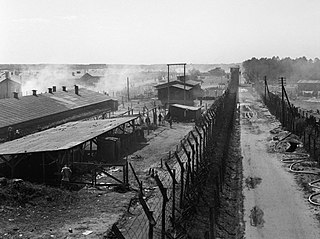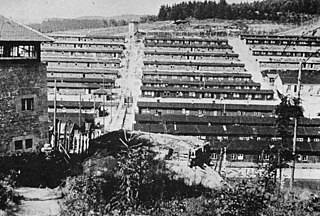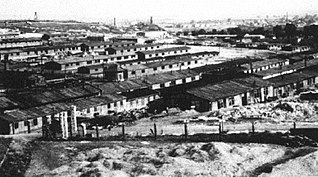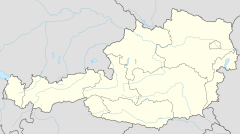
Buchenwald was a Nazi concentration camp established on Ettersberg hill near Weimar, Germany, in July 1937. It was one of the first and the largest of the concentration camps within the Altreich. Many actual or suspected communists were among the first internees.

Bergen-Belsen, or Belsen, was a Nazi concentration camp in what is today Lower Saxony in northern Germany, southwest of the town of Bergen near Celle. Originally established as a prisoner of war camp, in 1943, parts of it became a concentration camp. Initially this was an "exchange camp", where Jewish hostages were held with the intention of exchanging them for German prisoners of war held overseas. The camp was later expanded to hold Jews from other concentration camps.

Neuengamme was a network of Nazi concentration camps in northern Germany that consisted of the main camp, Neuengamme, and more than 85 satellite camps. Established in 1938 near the village of Neuengamme in the Bergedorf district of Hamburg, the Neuengamme camp became the largest concentration camp in Northwest Germany. Over 100,000 prisoners came through Neuengamme and its subcamps, 24 of which were for women. The verified death toll is 42,900: 14,000 in the main camp, 12,800 in the subcamps, and 16,100 in the death marches and bombings during the final weeks of World War II. Following Germany's defeat in 1945, the British Army used the site as an internment camp for SS and other Nazi officials. In 1948, the British transferred the land to the Free Hanseatic City of Hamburg, which summarily demolished the camp's wooden barracks and built in its stead a prison cell block, converting the former concentration camp site into two state prisons operated by the Hamburg authorities from 1950 to 2004. Following protests by various groups of survivors and allies, the site now serves as a memorial. It is situated 15 km southeast of the centre of Hamburg.

Flossenbürg was a Nazi concentration camp built in May 1938 by the SS Main Economic and Administrative Office. Unlike other concentration camps, it was located in a remote area, in the Fichtel Mountains of Bavaria, adjacent to the town of Flossenbürg and near the German border with Czechoslovakia. The camp's initial purpose was to exploit the forced labor of prisoners for the production of granite for Nazi architecture. In 1943, the bulk of prisoners switched to producing Messerschmitt Bf 109 fighter planes and other armaments for Germany's war effort. Although originally intended for "criminal" and "asocial" prisoners, after Germany's invasion of the Soviet Union, the camp's numbers swelled with political prisoners from outside Germany. It also developed an extensive subcamp system that eventually outgrew the main camp.

Mauthausen was a German Nazi concentration camp on a hill above the market town of Mauthausen, Upper Austria. It was the main camp of a group with nearly 100 further subcamps located throughout Austria and southern Germany. The three Gusen concentration camps in and around the village of St. Georgen/Gusen, just a few kilometres from Mauthausen, held a significant proportion of prisoners within the camp complex, at times exceeding the number of prisoners at the Mauthausen main camp.

Aufseherin was the position title for a female guard in Nazi concentration camps. Of the 50,000 guards who served in the concentration camps, training records indicate that approximately 3,500 were women. In 1942, the first female guards arrived at Auschwitz and Majdanek from Ravensbrück. The year after, the Nazis began conscripting women because of a shortage of male guards. In the context of these camps, the German position title of Aufseherin translates to (female) "overseer" or "attendant". Later female guards were dispersed to Bolzano (1944–1945), Kaiserwald-Riga (1943–44), Mauthausen, Stutthof (1942–1945), Vaivara (1943–1944), Vught (1943–1944), and at Nazi concentration camps, subcamps, work camps, detention camps and other posts.

Gross-Rosen was a network of Nazi concentration camps built and operated by Nazi Germany during World War II. The main camp was located in the German village of Gross-Rosen, now the modern-day Rogoźnica in Lower Silesian Voivodeship, Poland, directly on the rail-line between the towns of Jawor (Jauer) and Strzegom (Striegau). Its prisoners were mostly Jews, Poles and Soviet citizens.

Mittelbau-Dora was a Nazi concentration camp located near Nordhausen in Thuringia, Germany. It was established in late summer 1943 as a subcamp of Buchenwald concentration camp, supplying slave labour from many Eastern countries occupied by Germany, for extending the nearby tunnels in the Kohnstein and for manufacturing the V-2 rocket and the V-1 flying bomb. In the summer of 1944, Mittelbau became an independent concentration camp with numerous subcamps of its own. In 1945, most of the surviving inmates were sent on death marches or crammed in trains of box-cars by the SS. On 11 April 1945, US troops freed the remaining prisoners.

Płaszów or Kraków-Płaszów was a Nazi concentration camp operated by the SS in Płaszów, a southern suburb of Kraków, in the General Governorate of German-occupied Poland. Most of the prisoners were Polish Jews who were targeted for destruction by Nazi Germany during the Holocaust. Many prisoners died because of executions, forced labor, and the poor conditions in the camp. The camp was evacuated in January 1945, before the Red Army's liberation of the area on 20 January.

Sachsenhausen or Sachsenhausen-Oranienburg was a German Nazi concentration camp in Oranienburg, Germany, used from 1936 until April 1945, shortly before the defeat of Nazi Germany in May later that year. It mainly held political prisoners throughout World War II. Prominent prisoners included Joseph Stalin's oldest son, Yakov Dzhugashvili; assassin Herschel Grynszpan; Paul Reynaud, the penultimate prime minister of the French Third Republic; Francisco Largo Caballero, prime minister of the Second Spanish Republic during the Spanish Civil War; the wife and children of the crown prince of Bavaria; Ukrainian nationalist leader Stepan Bandera; and several enemy soldiers and political dissidents.
David Olère was a Polish-born French painter and sculptor best known for his explicit drawings and paintings based on his experiences as a Jewish Sonderkommando inmate at Auschwitz concentration camp during World War II.

Wöbbelin was a subcamp of the Neuengamme concentration camp near the city of Ludwigslust. The SS had established Wöbbelin to house concentration camp prisoners whom the SS had evacuated from other camps to prevent their liberation by the Allies. At its height, Wöbbelin held some 5,000 inmates, most of whom were suffering from starvation and disease. The camp was freed on May 2, 1945.
The Fürstengrube subcamp was a subcamp of the Auschwitz concentration camp, operated by Nazi Germany in 1943–1945 in Wesoła near Mysłowice in occupied Poland.
The Steyr-Münichholz concentration camp was one in a number of subcamps of the Mauthausen-Gusen concentration camp in Upper Austria. Inmates were drawn from the main camp, in order to exploit their labor for producing arms in Steyr-Daimler-Puch corporation factories, and to build air-raid bunkers in the town of Steyr.
Kazimierz Smoleń was a Polish political prisoner of the Nazi World War II KZ Auschwitz, and later a long-term director of Auschwitz-Birkenau State Museum.

Moshe Ha-Elion, also written Moshe Haelion, Moshe 'Ha-Elion, Moshé Ha-Elion, Moshé 'Ha-Elion, Moshé Haelyon, was a Holocaust survivor and writer. He survived Auschwitz, the death march, Mauthausen, Melk, and Ebensee. He is the author of a memoir, מיצרי שאול, originally written in Hebrew and translated into English as The Straits of Hell: The chronicle of a Salonikan Jew in the Nazi extermination camps Auschwitz, Mauthausen, Melk, Ebensee. He wrote three poems in Ladino based on his experience in the concentration camps and the death march: "La djovenika al lager", "Komo komian el pan", and "En marcha de la muerte", published in Ladino and Hebrew under the title En los Kampos de la Muerte. Moshe Ha-Elion translated Homer's Odyssey into Ladino. He lived in Israel. He had two children, six grandchildren, and nine great-grandchildren.

During World War II, the German Luftwaffe staffed dozens of concentration camps, and posted its soldiers as guards at many others. Camps created for the exploitation of forced labor for armaments production were often run by the branch of the Wehrmacht that used the products. The Wehrmacht also posted about 10,000 soldiers to concentration camps because of a shortage of guards in mid-1944, including many from the Luftwaffe.

Gusen was a subcamp of Mauthausen concentration camp operated by the SS between the villages of Sankt Georgen an der Gusen and Langestein in the Reichsgau Ostmark. Primarily populated by Polish prisoners, there were also large numbers of Spanish Republicans, Soviet citizens, and Italians. Initially, prisoners worked in nearby quarries, producing granite which was sold by the SS company DEST.



















